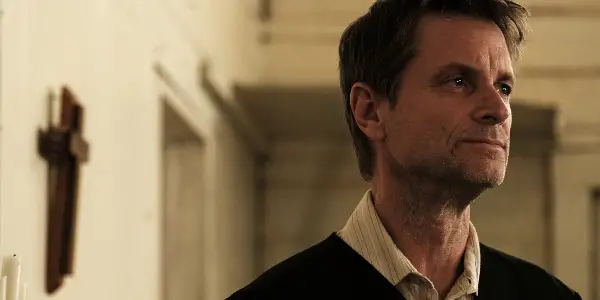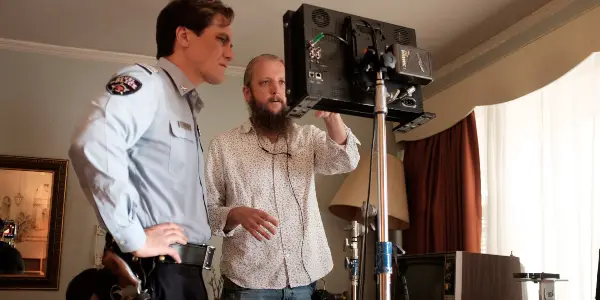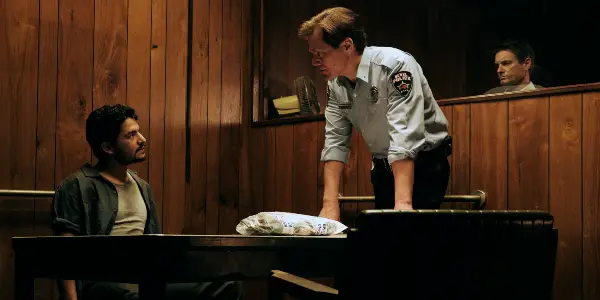SXSW 2020: Interview with THE QUARRY Director/Co-Writer Scott Teems

Kevin L. Lee is an Asian-American critic, producer, screenwriter and…
The Quarry was one of my most anticipated films of SXSW 2020. Carefully paced, well-acted, and authentic in its setting and themes, the film is one that you should not miss, especially if you’re a fan of films that take advantage of the Texas landscape.
With a simple premise of a man (Shea Whigham) on the run posing as a reverend, The Quarry plays like a tense game of cat and mouse between the runaway and the town sheriff (Michael Shannon). Along the way, the film offers some nuanced perspectives on the many prejudices that still exist in our country today.
The following is the interview I had with director/co-writer Scott Teems, where we talked about the film’s many themes and how it was produced and brought to the big screen. But first, we had to get the cancellation of SXSW out of the way.
Kevin L. Lee for Film Inquiry: First I wanna start by saying my heart goes out to you and your cast and crew for trying to adapt to these unprecedented times. I’m glad I got to see your film, I’m glad I have the opportunity to talk to you over the phone today.
Scott Teems: Hey, thanks, man. Yeah, you know, it’s… it’s hard, you know? You work a long time for years and years, trying to make a movie, and then to lose that opportunity to premiere it to the world. It’s sad, you know? In the grand scheme of all the terrible things happening in our world, it’s small, but that doesn’t mean it doesn’t hurt. It does hurt, it’s a heartbreaker. You know you want to celebrate with the people you worked with. You wanna show the world and have all the beautiful things that a film festival brings and offers you and the world and the film community. I love festivals. They’re a huge part of my life and to lose that was a heartbreaker, but I do think there’s a silver lining which is people are staying home and this movie could be available in three weeks to them and hopefully more people will get to see it. Maybe more than they would’ve if we had our traditional theatrical release, which now looks like it’s gonna not happen either, which is sad but I really hope they’ll get to see it. With fewer new releases, we’ll have less competition and get more people to see it.
And of course, I will do everything I can to spread the word, recommend it to people. I really did enjoy the film.
Scott Teems: Thanks a lot, and thank you.

So, let’s talk about the backdrop. This movie is based on the novel by the same name by Damon Galgut. In that novel, the story took place in South Africa, and it captured the bleak desolate landscape of South Africa. In the film, however, the story takes place in West Texas. Can you explain what was the inspiration behind that change?
Scott Teems: I read the novel about 10 years ago, in the wake of my first movie That Evening Sun, and I was looking for a new project. I came across the novel and was instantly grabbed by the premise. It’s got a classic premise at its core – a stranger comes into town, pretending to be someone he’s not. I love that kind of setup and idea. It deals with racial tensions in post-apartheid South Africa in a small town. And instantly… like you said, the barren plains of coastal South Africa, instantly I thought of West Texas. Obviously, in America, we have our own racial conflicts and stripes, and so it just felt like a real natural translation both in the feel of the place and the tension built into the racial conflict. It felt relevant to me, even 10 years ago, and it only feels more relevant today and so that was a natural way to bring the film to the US in a way that I can write it more authentically.
So, one of the things I loved a lot about the film was, as you said, the racial tensions surrounding the immigrants, but it doesn’t clearly take sides, if you know what I mean. Can you walk me through the writing process in finding that balance?
Scott Teems: I’ve always been drawn to shades of grey. Nobody is all good or all bad. When characters are one or the other in stories or movies, they tend to bore me because they don’t feel real. What I love as an audience member watching movies, and therefore in trying to tell stories, is when my allegiances are torn. I love when I don’t know which side to take because that then engages me as a viewer, and it makes me actually have to think about what is right and what is wrong in this scenario. That’s one of the things I loved about the idea of making this movie because on the page – this is the difference between writing and the magic of filmmaking – it may read a bit more black and white, but when you have someone like Michael Shannon or someone like Shea Whigham and even Bobby Soto, who plays Valentin, those guys bring so much internal life to these characters.
Mike Shannon, he’s a very charismatic person, a charming actor and I love the idea of putting this guy who’s doing terrible things but he’s doing it with charm and with a smile, and it’s not disingenuous. I think he’s blind to his own prejudice, in a lot of ways. I think that’s sort of how most prejudices exist in the world. It’s sort of a more casual, less overt way. Most racists aren’t mustache-twirling people who just hate everyone of a certain color or ethnicity. Most racists don’t realize they’re racists, that’s my experience at least. I come from Georgia, and like anywhere in this country, there’s racism that’s prevalent in a lot of places, but a lot of people won’t recognize it because it’s sort of built in. It’s a sort of blind spot that happens when people are different from us, and we have to be aware of it in order to move beyond it, and most of us just aren’t even aware of it. That’s the case with this chief. You have someone like Mike Shannon, who’s just trying to do his job and his first instinct is to blame the guy who doesn’t look like him, based on his history, his personal history, based on the world. He’s not overtly evil, he’s just blind, and I think that’s a more truthful expression of a lot of the racism I experienced.

Since you emphasized a lot on Michael Shannon’s character, I was going to ask this last, but I’ll jump to it now. How was it decided that Shea was going to play the man on the run and Michael was going to play the sheriff? Was there ever a talk of them playing the opposite role? What was the casting process like?
Scott Teems: You know, it’s funny. I joked that if this were a play, we could do it like True West, and they could switch roles every night and it would be really interesting.
*Laughs*
Scott Teems: I was really fortunate to have two of my favorite actors, and two of the best actors working today, but it really was Shea’s interest in the movie that got it made.
I wrote this 10 years ago, tried to make it 10 years ago, couldn’t make it. The project died and it went away, and I hadn’t thought about it for 6-7 years. Shea got his hands on the script through Kristin Mann, who was one of the producers and it was his interest that brought it back to life and Shea’s interest in playing the man. I was excited when that came up because Shea is one of my favorite actors. The idea of giving him his first real lead role was exciting for me and I think he’s long deserved to play the lead in a movie. Giving him this chance was really wonderful.
So, Shea came on first, and actually, I had given the script to Mike [Shannon] 10 years ago, back when I was first trying to make it, and he was unavailable. He was off making Superman for a year (Man of Steel). That’s how long ago this was, and it was beautiful when it came back around. Shea was interested because Shea and Mike are longtime friends and also Kristin and Mike are longtime friends, so that brought Mike back into the fold, and Mike was excited to support Shea in his lead role as well. It was a beautiful thing, two friends wanting to help each other out and wanting to work together.
That’s awesome. One other thing I was a big fan of in the film was the editing techniques and finding the right moment to incorporate a musical score. It really got you to live inside the protagonist’s mind. I’m curious as to which filmmaker or films inspired your aesthetic and your directing sensibilities.
Scott Teems: That’s a good question. I definitely have to credit Saira Haider, the editor, and Heather McIntosh, who composed the score. So, Haider did a lot of great stuff. She created a few of these cross-cutting sequences, for example, the sequence with the baptism and when Poco (one of the characters) discovers the body. It was sort of a life and death cross-cutting. It was not written that way; it was written to be more sequential.
I see.
Scott Teems: Saira took that opportunity and saw this thematic resonance between life and death and she cut that scene. Same thing later on, when the chief is searching the house while Shea is giving his sermon – it’s another sequence that Saira intercut and found this beautiful cross-cutting technique to create more of a lyricism in the editing. There was a real poetry to how she cut the movie that I think really helped a ton. Now, any time you make a Texas thriller, at least in the last 10 years, you live in the shadow of No Country for Old Men, and that’s okay.
*Laughs*
Scott Teems: I’m happy to live in that shadow, it’s one of the greatest movies in the last 20 years and one of my favorites. I’m happy to be inspired by that and certainly the stark feel of that film is something we all aspired to when we were making this film. Paris, Texas is another huge influence on me and on this film. But a lot of the poetry, if there’s any poetry, comes from Krzysztof Kieślowski, who’s my favorite filmmaker. I try to shoot my close-ups like he does, and he does these beautiful close-ups of objects and abstractions. All the close-ups of the hands in the movie are sort of influenced by Kieślowski, and I try to give it a bit of poetry in the imagery. Trying to bring that poetry into a starker, more sparse setting.

Oh, I see it. I see it. Gotcha. So, one last question, the town that’s featured in the film. I thought it had a striking balance of barren yet lived in. There was wear and tear but also enough details of furniture, clothes, all to show that people still live there. How much of that was built and how much was inspired by real locations?
Scott Teems: That was a real town we found. The main street is a real place, but then Erin Magill, the production designer, just augmented and transformed the experience of that place into this lived-in, weathered town. The interiors, the church, so she built that whole interior church. It just looks so real, and like you said, lived in and authentic. Annell Brodeur, who did the costumes, complemented that really well, but it was Erin’s work designing the film and building those locations. The entire interior of the police station was built. Chief’s office, interrogation room, the jail cell, all that was built. None of that was there. So, the jail cell she built, it almost feels iconic in a way. It’s iconic in its simplicity. It feels like a relic. It gives, hopefully, a classic feel. There were three principal locations: the church, the house, and the police station. And then you could stumble upon these amazing natural exterior locations, like the river where the baptism takes place. It’s this wonderful park we found, with these amazing trees that were spread apart, and we were really fortunate to capture the beauty of that place, but it was definitely a combination of real vs built. I think Erin did an amazing job and Mike Lloyd, the DP, captured all that too in a wonderful way.
Amazing. Mr. Scott Teems, thank you so much for talking with me today.
Film Inquiry thanks Scott Teems for taking the time to speak with us.
The Quarry was originally planned to premiere at SXSW 2020. Lionsgate and Grindstone, a Lionsgate Company will release The Quarry On Demand on April 17, 2020.
Does content like this matter to you?
Become a Member and support film journalism. Unlock access to all of Film Inquiry`s great articles. Join a community of like-minded readers who are passionate about cinema - get access to our private members Network, give back to independent filmmakers, and more.
Kevin L. Lee is an Asian-American critic, producer, screenwriter and director based in New York City. A champion of the creative process, Kevin has consulted, written, and produced several short films from development to principal photography to festival premiere. He has over 10 years of marketing and writing experience in film criticism and journalism, ranging from blockbusters to foreign indie films, and has developed a reputation of being “an omnivore of cinema.” He recently finished his MFA in film producing at Columbia University and is currently working in film and TV development for production companies.













